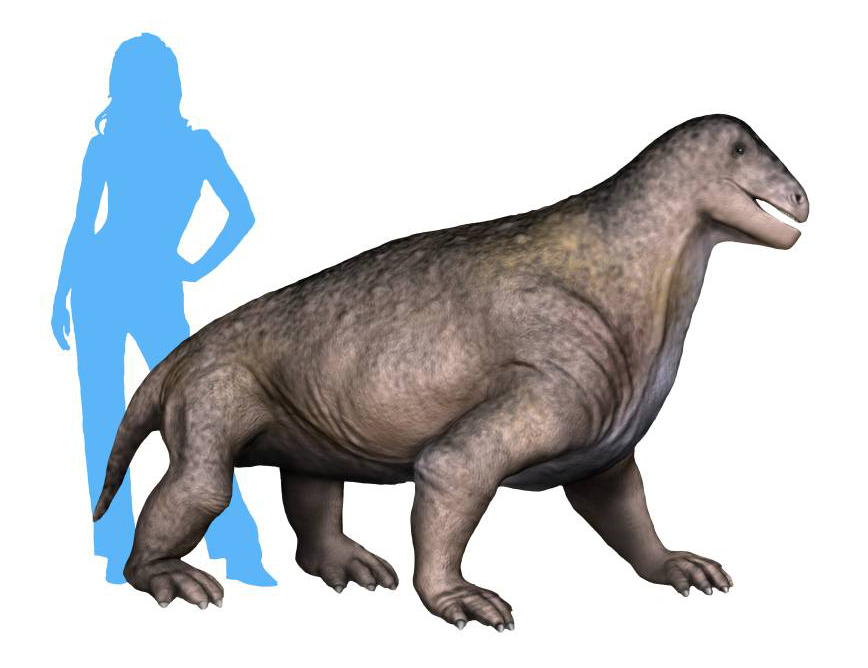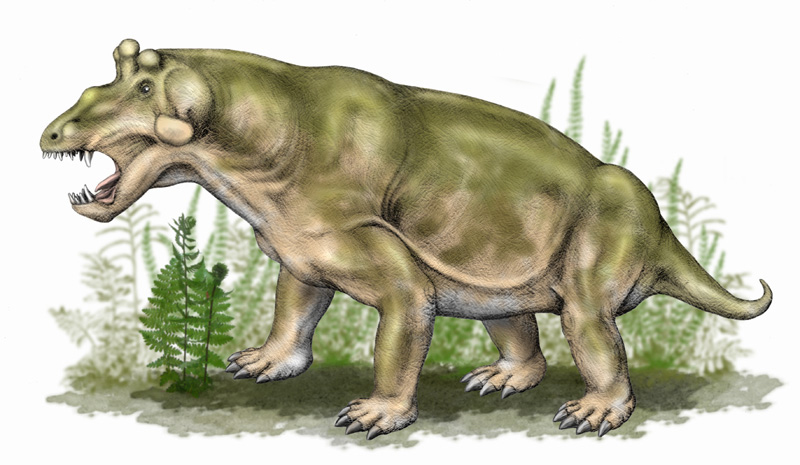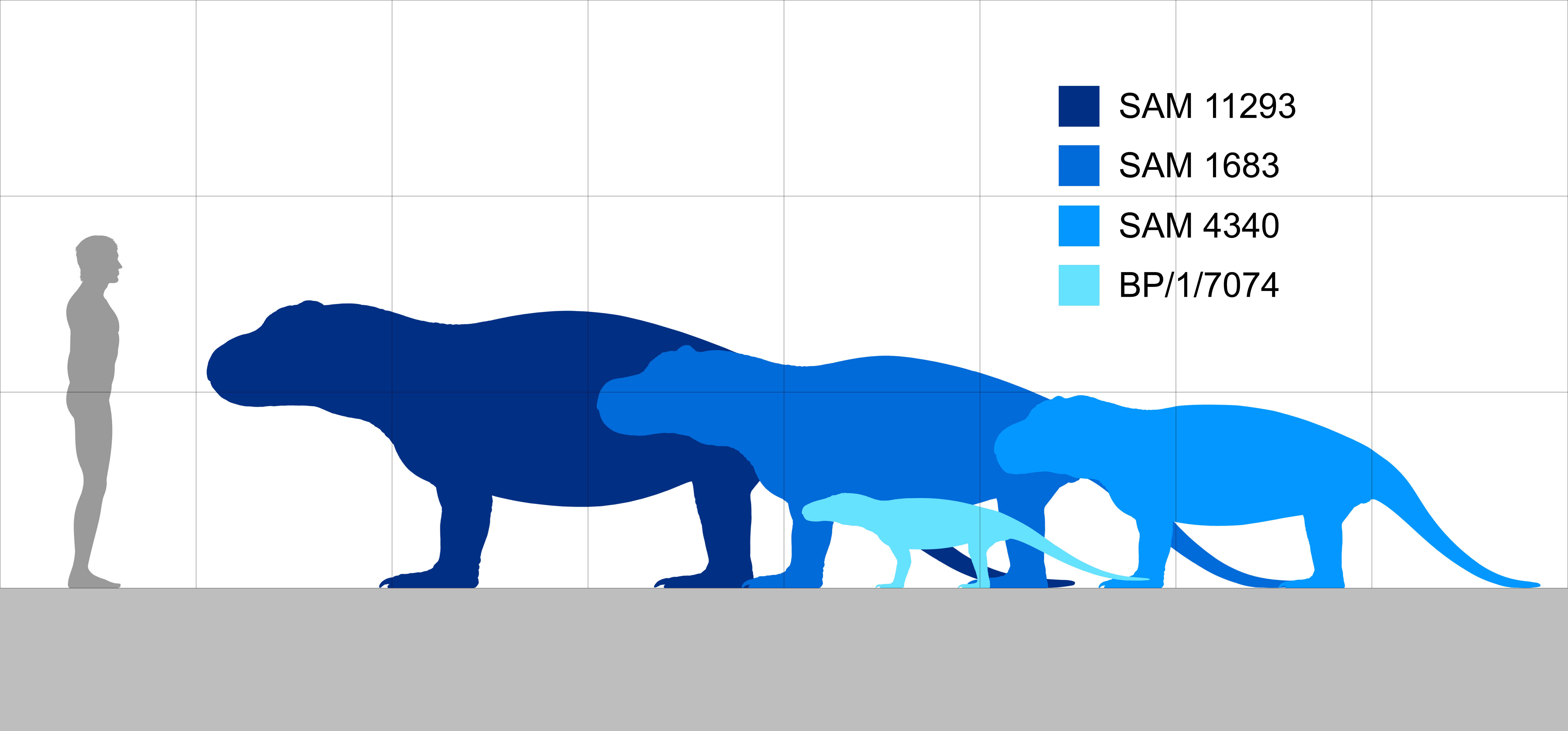|
Dinocephalians
Dinocephalians (terrible heads) are a clade of large-bodied early therapsids that flourished in the Early and Middle Permian between 279.5 and 260 million years ago (Ma), but became extinct during the Capitanian mass extinction event. Dinocephalians included herbivorous, carnivorous, and omnivorous forms. Many species had thickened skulls with many knobs and bony projections. Dinocephalians were the first non-mammalian therapsids to be scientifically described and their fossils are known from Russia, China, Brazil, South Africa, Zimbabwe, and Tanzania. Description Apart from the Biarmosuchians, the dinocephalians are the least advanced therapsids, although still uniquely specialised in their own way. They retain a number of primitive characteristics (e.g. no secondary palate, small dentary) shared with their pelycosaur ancestors, although they are also more advanced in possessing therapsid adaptations like the expansion of the ilium and more erect limbs. They include carnivoro ... [...More Info...] [...Related Items...] OR: [Wikipedia] [Google] [Baidu] |
Pachyostosis
Pachyostosis is a non-pathological condition in vertebrate animals in which the bones experience a thickening, generally caused by extra layers of lamellar bone. It often occurs together with bone densification (osteosclerosis), reducing inner cavities. This joint occurrence is called pachyosteosclerosis. However, especially in the older literature, "pachyostosis" is often used loosely, referring to all osseous specializations characterized by an increase in bone compactness and/or volume. It occurs in both terrestrial and, especially, aquatic or semi-aquatic vertebrates. In aquatic animals, such as seacows (manatees and dugongs), ''Thalassocnus'', and plesiosaurs, pachyostosis in the thoracic region provides (or provided) ballast against the air-filled lungs. This maintains neutral buoyancy in aquatic habitats. Most giant deer showed pronounced pachyostosis of the mandible and skull. It has been suggested that this served to store minerals for antler growth. Many Pachycephalosau ... [...More Info...] [...Related Items...] OR: [Wikipedia] [Google] [Baidu] |
Ulemosaurus
''Ulemosaurus'' is an extinct genus of dinocephalian therapsids that lived 265 to 260 million years ago, at Isheevo in Russian Tatarstan. It was a tapinocephalid, a group of bulky herbivores which flourished in the Middle Permian. ''Ulemosaurus'' and other tapinocephalians disappeared at the end of the Middle Permian. Description Only several partial skeletons and skulls have been found. The skull bones are extremely dense: about at its thickest. This thickening is possibly related to head-butting behavior, as some researchers suggest. The species is considered a herbivore, but because the mandible is heavily constructed some palaeontologists consider it a carnivore, with the species being able to use muscle power to cut prey up with its incisors. Classification ''Ulemosaurus'' is a large ''Moschops''-like form from Russia; it is probably similar enough to be included as a separate species of ''Moschops''. Despite its advanced characteristics, it lived slightly before the Karoo ... [...More Info...] [...Related Items...] OR: [Wikipedia] [Google] [Baidu] |
Permian
The Permian ( ) is a geologic period and stratigraphic system which spans 47 million years from the end of the Carboniferous Period million years ago (Mya), to the beginning of the Triassic Period 251.9 Mya. It is the last period of the Paleozoic Era; the following Triassic Period belongs to the Mesozoic Era. The concept of the Permian was introduced in 1841 by geologist Sir Roderick Murchison, who named it after the region of Perm in Russia. The Permian witnessed the diversification of the two groups of amniotes, the synapsids and the sauropsids ( reptiles). The world at the time was dominated by the supercontinent Pangaea, which had formed due to the collision of Euramerica and Gondwana during the Carboniferous. Pangaea was surrounded by the superocean Panthalassa. The Carboniferous rainforest collapse left behind vast regions of desert within the continental interior. Amniotes, which could better cope with these drier conditions, rose to dominance in place of their am ... [...More Info...] [...Related Items...] OR: [Wikipedia] [Google] [Baidu] |
Moschops BW
''Moschops'' (Greek for "calf face") is an extinct genus of therapsids that lived in the Guadalupian epoch, around 265–260 million years ago. They were heavily built plant eaters, and they may have lived partly in water, as hippopotamuses do. They had short, thick heads and might have competed by head-butting each other. Their elbow joints allowed them to walk with a more mammal-like gait rather than crawling. Their remains were found in the Karoo region of South Africa, belonging to the ''Tapinocephalus'' Assemblage Zone. Therapsids, such as ''Moschops'', are synapsids, the dominant land animals in the Permian period, which ended 252 million years ago. Description ''Moschops'' were heavy set dinocephalian synapsids, measuring in length, and weighing on average and in maximum body mass. They had small heads with broad orbits and heavily-built short necks. Like other members of Tapinocephalidae, the skull had a tiny opening for the pineal organ. The occiput was broad and ... [...More Info...] [...Related Items...] OR: [Wikipedia] [Google] [Baidu] |
Early Permian
01 or '01 may refer to: * The year 2001, or any year ending with 01 * The month of January * 1 (number) Music * '01 (Richard Müller album), 01'' (Richard Müller album), 2001 * 01 (Son of Dave album), ''01'' (Son of Dave album), 2000 * 01 (Urban Zakapa album), ''01'' (Urban Zakapa album), 2011 * O1 (Hiroyuki Sawano album), ''O1'' (Hiroyuki Sawano album), 2015 * 01011001, the seventh studio album from Arjen Anthony Lucassen's Ayreon project Other uses * 01 (telephone number), United Kingdom internal dialing code for London between the late 1950s and 1990 * Lynk & Co 01, a compact SUV built since 2017 * Zero One also known as ''Machine City'', a city-state from the ''The Matrix (series), Matrix'' series * Kolmogorov's zero-one law, a law of probability theory * Pro Wrestling ZERO1-MAX, a wrestling promotion formerly known as Pro Wrestling ZERO-ONE * BAR 01, a Formula One chassis * The number of the French department Ain * The codename given to the Wing Gundam by Oz in the anime ''G ... [...More Info...] [...Related Items...] OR: [Wikipedia] [Google] [Baidu] |
Dentary
In anatomy, the mandible, lower jaw or jawbone is the largest, strongest and lowest bone in the human facial skeleton. It forms the lower jaw and holds the lower tooth, teeth in place. The mandible sits beneath the maxilla. It is the only movable bone of the skull (discounting the ossicles of the middle ear). It is connected to the temporal bones by the temporomandibular joints. The bone is formed prenatal development, in the fetus from a fusion of the left and right mandibular prominences, and the point where these sides join, the mandibular symphysis, is still visible as a faint ridge in the midline. Like other symphyses in the body, this is a midline articulation where the bones are joined by fibrocartilage, but this articulation fuses together in early childhood.Illustrated Anatomy of the Head and Neck, Fehrenbach and Herring, Elsevier, 2012, p. 59 The word "mandible" derives from the Latin word ''mandibula'', "jawbone" (literally "one used for chewing"), from ''wikt:mandere ... [...More Info...] [...Related Items...] OR: [Wikipedia] [Google] [Baidu] |
Styracocephalus
''Styracocephalus platyrhynchus'' ('spike head') is an extinct species of tapinocephalian therapsids that lived during the Guadalupian epoch. ''Styracocephalus''s head ornament meant that it could be recognised from a distance. The most striking feature of ''Styracocephalus'' are the large backward-protruding tabular horns. The crest stuck upwards and backwards, but there is some variation in its shape, and this suggests that it changed throughout life and that it may be sexually dimorphic. ''Styracocephalus'' was a herbivore that may have been fully terrestrial or partly aquatic like the modern hippopotamus. It may have evolved from the estemmenosuchids. Its remains are known from South Africa but it probably had a wider distribution. It was around in length, with a , skull. See also * List of therapsids This list of therapsids is an attempt to create a comprehensive listing of all genera that have ever been included in the Therapsida excluding mammals and purely ve ... [...More Info...] [...Related Items...] OR: [Wikipedia] [Google] [Baidu] |
Estemmenosuchus
''Estemmenosuchus'' (meaning "crowned crocodile" in Greek) is an extinct genus of large, early omnivorous therapsid. It is believed and interpreted to have lived during the middle part of the Middle Permian around 267 million years ago. The two species, ''E. uralensis'' and ''E. mirabilis'', are characterised by distinctive horn-like structures, which were probably used for intra-specific display. Both species of ''Estemmenosuchus'' are from the Perm (or Cis-Urals) region of Russia. Two other estemmenosuchids, ''Anoplosuchus'' and ''Zopherosuchus'', are now considered females of the species ''E. uralensis''. There were many complete and incomplete skeletons found together. Description ''Estemmenosuchus'' could reach a body length of more than . Its skull was long and massive, up to in length, and possessed several sets of large horns, somewhat similar to the antlers of a moose, growing upward and outward from the sides and top of the head. The animal had a sprawling posture a ... [...More Info...] [...Related Items...] OR: [Wikipedia] [Google] [Baidu] |
Anteosaurus
''Anteosaurus'' (meaning "Antaeus reptile") is an extinct genus of large carnivorous dinocephalian synapsid. It lived at the end of the Guadalupian (= Middle Permian) during the Capitanian stage, about 265 to 260 million years ago in what is now South Africa. It is mainly known by cranial remains and few postcranial bones. With its skull reaching in length and a body size estimated at more than in length, and in weight, ''Anteosaurus'' was the largest known carnivorous non-mammalian synapsid and the largest terrestrial predator of the Permian period. Occupying the top of the food chain in the Middle Permian, its skull, jaws and teeth show adaptations to capture large prey like the giants titanosuchids and tapinocephalids dinocephalians and large pareiasaurs. As in many other dinocephalians the cranial bones of ''Anteosaurus'' are pachyostosed, but to a lesser extent than in tapinocephalid dinocephalians. In ''Anteosaurus'', pachyostosis mainly occurs in the form of horn-sha ... [...More Info...] [...Related Items...] OR: [Wikipedia] [Google] [Baidu] |
Titanosuchus
''Titanosuchus ferox'' ("Fierce titan crocodile") is an extinct species of dinocephalian therapsids that lived in the Middle Permian epoch in South Africa. Along with its close relatives, ''Jonkeria'' and ''Moschops'', ''Titanosuchus'' inhabited present-day South Africa around 265 million years ago, in the Late Permian. ''Titanosuchus'' was a carnivore which measured over 2.5 m long and might have eaten both ''Jonkeria'' and ''Moschops'', among other vertebrates. Its teeth included sharp incisors and fang-like canines, perfect for biting prey. ''Titanosuchus'' should not be confused with the therapsid ''Eotitanosuchus'', which belonged to a different family. ''Parascapanodon'' and ''Scapanodon'' were once thought to be distinct genera, but are now considered to be junior synonyms of ''Titanosuchus''.Boonstra, L. D., 1969, The fauna of the Tapinocephalus zone (Beaufort beds of the Karoo): Annals of the South African Museum, v. 56, part 1, p. 1-73. See also * List of therapsids ... [...More Info...] [...Related Items...] OR: [Wikipedia] [Google] [Baidu] |
Tapinocephalus
''Tapinocephalus'' ("humble head") is an extinct genus of large herbivorous dinocephalians that lived during the Middle Permian Period. These stocky, barrel-bodied animals were characterised by a massive bony skull roof and short weak snout. It is thought that, like the rest of the members of its family, the animals engaged in head-butting intraspecific behavior, possibly for territory or mates. The fossil remains (skull and postcranial elements) of ''Tapinocephalus'' are known from the Lower, Middle, and Upper part of the ''Tapinocephalus'' Assemblage Zone ( Capitanian age) of the Lower Beaufort Beds of the South African Karoo. Only the type species, ''T. atherstonei'' is now considered valid for this genus. In life, these animals were over in length and massed around , making them among the largest animals of their time. Classification ''Tapinocephalus atherstonei'' is known from a number of skulls and postcranial bones. The skull is large with a heavily pachyostotic ... [...More Info...] [...Related Items...] OR: [Wikipedia] [Google] [Baidu] |
Pareiasaur
Pareiasaurs (meaning "cheek lizards") are an extinct clade of large, herbivorous parareptiles. Members of the group were armoured with scutes which covered large areas of the body. They first appeared in southern Pangea during the Middle Permian, before becoming globally distributed during the Late Permian. Pareiasaurs were the largest reptiles of the Permian, reaching sizes equivalent to those of contemporary therapsids. Pareiasaurs became extinct at the end of the Permian during the Permian-Triassic extinction event. Description Pareiasaurs ranged in size from long, and may have weighed up to . They were stocky, with short tails, small heads, robust limbs, and broad feet. The cow-sized species '' Bunostegos'', which lived 260 million years ago, is the earliest known example of a tetrapod with a fully erect posture as its legs were positioned directly under its body. Pareiasaurs were protected by bony scutes called osteoderms that were set into the skin. Their heavy skulls wer ... [...More Info...] [...Related Items...] OR: [Wikipedia] [Google] [Baidu] |








